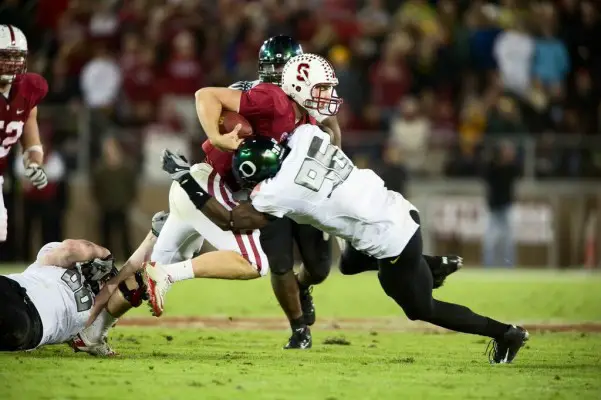
Andrew Luck
In recent days and weeks leading to Oregon’s season-defining showdown with heretofore undefeated Stanford, the story wasn’t just that Chip Kelly‘s team was facing the nation’s #4 squad, or that a win might make another BCS title-game run possible. Given the accolades that have been showered for the past two years on Cardinal quarterback Andrew Luck, it seems the Ducks had a rare challenge on their hands: against a signal caller who might one day occupy a place in the Pro Football Hall of Fame.
Time after time this season, TV commentators have anointed Luck the top prospect at his position since Peyton Manning and John Elway—the latter two being the standard bearers for legendary NFL quarterbacks. Only time will tell what kind of a pro Gil Luck’s son will become. We pretty much know he’ll be the first pick, but then again, so were David Carr, Tim Couch, and a host of others who have not lived up to expectations. Yet if Luck were to go on to the Hall of Fame, he would join just four other quarterbacks the Ducks have faced who have earned that ultimate distinction.
In the modern era, dating from about 1950, there have only been 23 quarterbacks to earn enshrinement in Canton. Elway (1-1), Troy Aikman (1-0), Jim Plunkett (3-0) and Warren Moon (3-0) are the only ones to compete against the Ducks.
Jim Plunkett
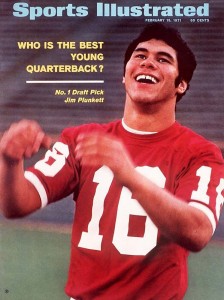
Before Elway and Luck at The Farm, there was Plunkett
Like most players of his era, Stanford’s Jim Plunkett did not play his freshman year, but by 1968 he was enshrined at starter. In just his second game, Plunkett engineered a 28-12 win in the Cardinal’s first trip to Autzen Stadium since its opening the year before. As a junior, en route to Pacific 8 Conference records for touchdown passes (20), passing yards (2,673) and total offense (2,786), he again had Oregon’s number with a 28-0 victory over Jerry Frei’s team. That year Washington State coach Jim Sweeney called Plunkett “the best college football player I’ve ever seen.”
In Plunkett’s senior year, 1970, his 2,715 passing yards broke his own conference record. He won the Heisman Trophy over fellow signal callers Archie Manning of Mississippi and Joe Theismann of Notre Dame. Plunkett that year also led Stanford to their first Rose Bowl appearance since 1952, a 27-17 upset of Ohio State. But his only encounter with another future Hall of Fame quarterback that year would come against the Ducks and signal caller Dan Fouts. Although Oregon that year would secure its first winning season since 1964, Plunkett and company again walked away the victors, 33-10 in Eugene.
A decade later, after a heretofore up and down pro career that saw him quarterback the New England Patriots and San Francisco 49ers, Plunkett would lead the 1980 Oakland Raiders to a victory over Philadelphia in Super Bowl XV and another (by which time he was 36 years old) over Washington in Super Bowl XVIII.
Warren Moon
The three seasons this prolific future NFL and CFL star played for Washington, 1975-77, were not good ones for the Ducks. 1975 and ’76, under head coach Don Read, were 3-8 and 4-7 campaigns. These teams weren’t just failing to win; they were in many cases being thoroughly embarrassed: 62-7 to Oklahoma and 50-17 to UCLA in 1975, then the next year a 53-0 loss to USC, 41-0 to Notre Dame and 46-0 to the Bruins.
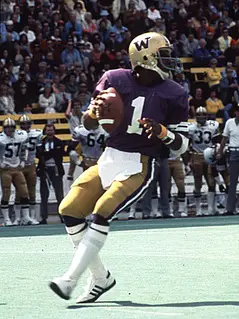
Warren Moon starred for Washington from 1975-77
Meanwhile, the Washington Huskies were beginning their most successful era under Don James, who debuted in Seattle the same year as Moon. Other colleges had tried to convert Moon, like many African American players of that time seeking to play quarterback, to a different position. After a record-setting season in junior college, the Los Angeles native selected Washington because they allowed him to remain under center. Moon and James found only mediocre results in their first two years together, with 6-5 and 5-6 results in 1975 and ’76. Those years included a 27-17 win over the Ducks at Autzen and a 14-7 vesting of Read’s team in Seattle.
1977 was the inaugural campaign for Rich Brooks, and the team initially was even worse than it had been under Read, finishing 2-9 that year and in 1978. In the ’77 game at Autzen, Moon led the Huskies to a 54-0 annihilation of the Ducks in Eugene. It was particularly these years in the late 1970s and early 1980s that fueled many Duck fans’ animosity toward Washington as their James-led teams rose to prominence. The Moon-led 1977 Huskies squad finished the season 10-2 including an upset Rose Bowl win over Michigan.
John Elway
The leader at Stanford from 1979-82, John Elway passing for 9,349 yards and 77 touchdowns but just a 20-23 record. His 24 touchdown passes in 1982 led the nation, when he was named first-team All American finished second in the Heisman Trophy balloting. In 2007, Elway was ranked #15 on ESPN’s Top 25 Players In College Football History list.
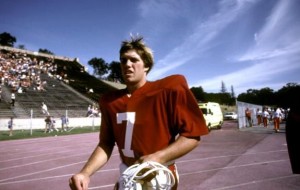
John Elway was 20-23 in his career at Stanford
Although Elway didn’t play much as a freshman (senior and future pro Turk Schonert was the starter) in 1979, the year when Rich Brooks’s Ducks beat Stanford 16-7 in Palo Alto, he was indeed under center during a 35-25 loss to the Ducks at Autzen to begin the 1980 season. That year Oregon had a star of its own in Reggie Ogburn, a run-oriented quarterback who prefigured stars of the current era such as Dennis Dixon, Jeremiah Masoli and Darron Thomas. Beating Stanford that year was no easy feat. Earlier that season, after Elway threw for three touchdowns (and ran for another) in Stanford’s stunning 31-14 upset of Oklahoma in Norman, Sooners Coach Barry Switzer said, “John Elway put on the greatest exhibition of quarterback play and passing I’ve ever seen on this field.”
However, in 1981 the future two-time Super Bowl champion winning quarterback of the Denver Broncos had a field day against the Ducks as the Cardinal won easily, 42-3. Oregon would finish that year 2-9 after NCAA probations reversed a streak of two straight winning seasons. In a twist of scheduling fate, it was the second and last time Oregon faced Elway, for his senior season was one of the rare years the two schools, whose series dates back to the year 1900, did not play. Elway’s career at Stanford was capped by losing to archrival Cal in 1982 in what’s called “The Game,” on a famous winning kick return as time expired that also leveled members of the Cardinal marching band.
Troy Aikman
The Ducks’ lone matchup against UCLA’s future Canton-enshrined Aikman, in 1988, was a case of what might have been.
That year, behind sophomore Bill Musgrave, Oregon started 6-1 only to finish 6-6 after the quarterback was lost to a season-ending collarbone injury in the eighth game of the season against Arizona State. The Ducks were driving toward what would have been a go-ahead touchdown against the Sun Devils when the injury occurred. The next week, with a nationwide TV audience watching on ABC, Aikman and head coach Terry Donahue‘s Bruin’s came to town for what was expected to be a duel between two of the Pac-10’s best quarterbacks.
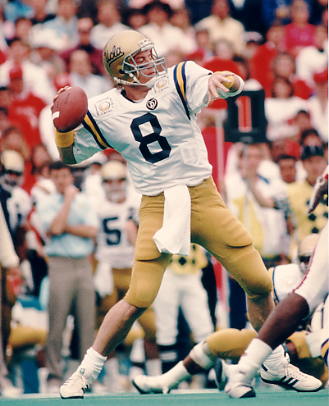
Troy Aikman struggled against Oregon’s defense in 1988 despite a 16-6 Bruins win
Instead, with Pete Nelson under center, the Ducks made a valiant effort, holding Aikman’s offense largely ineffective only to fall 16-6. “He had done some good things,” Brooks said of Nelson in a 2006 interview for my book, Tales From the Oregon Ducks Sideline. “He’d come in against the year before Nebraska when Chris Miller got hurt and threw the ball very well.”
Even so, the Aikman game is one of the biggest what-if moments from Musgrave’s storied career in Eugene, particularly that year, in which bowl games and Pac-10 titles first began to seem like a possibility. “We had a fantastic defense,” Musgrave told me in 2006. “And on offense we had matured from the year before. I don’t think it’d be any stretch to say that was the best team I was on in my four years at Oregon.” After facing the Ducks, Aikman himself would of course go on to become the first pick and the draft and, in Hall of Fame career, lead the Dallas Cowboys to three Super Bowl wins.
Other Notables and Oregon’s Own Quarterback Pedigree
Besides this quartet of Hall of Fame QBs, Oregon has also faced two others who, while not enshrined in Canton, did lead their teams to Super Bowl victories: Mark Rypien and Aaron Rodgers. The Ducks came away with victories against both, going 1-1 against Rypien’s Washington State Cougars in 1984 and 1985, and 1-1 against Rodgers’ Cal Bears in 2003 and 2004.
Of course there is no guarantee that Andrew Luck will go on to be a Hall of Fame quarterback or even a mediocre one. For every quarterback enshrined in Canton there are countless others who did not measure up, including many very successful in college. Heisman Trophy winning QBs that Oregon has faced such as Terry Baker, Ty Detmer, Carson Palmer and Matt Leinart all had careers that were mixed at best.
But if Andrew Luck does happen to go on to earn a statuette in Canton some day, he will improve considerably Oregon’s existing 1-8 record against these Hall of Fame signal callers given just a 1-2 record against Chip Kelly’s squad.
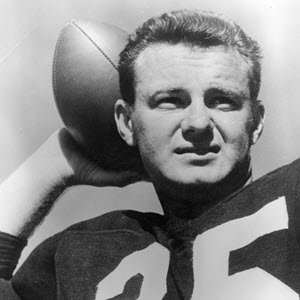
Norm Van Brocklin
As long as we’re talking about the quarterback position, the Pro Football Hall of Fame and the Ducks, let’s not forget one other fact, which can do a lot to temper the losing record against these all-time greats of the past: Oregon is one of only four schools to have two quarterbacks with busts in Canton (Dan Fouts and Norm Van Brocklin), joining only Purdue (Bob Griese and Len Dawson), UCLA (Aikman and Bob Waterfield), and of course Stanford. Of these, Purdue will eventually have three assuming Drew Brees is inducted. Stanford even besides the possibility of Andrew Luck could easily have three if former 49ers great John Brodie were in the Hall.
Even so, for a program that according to many media accounts has only risen to prominence recently, the Ducks can offer a very stout resume of all-time greats. After all, not only does Oregon have the rarity of two quarterbacks in the Hall, but also only six schools (USC, Notre Dame, Michigan, Ohio State, Alabama and Syracuse) have more players overall enshrined.
Brian Libby
Portland Oregon
Related Articles:
Brian Libby is a writer and photographer living in Portland. A life-long Ducks football fanatic who first visited Autzen Stadium at age eight, he is the author of two histories of UO football, “Tales From the Oregon Ducks Sideline” and “The University of Oregon Football Vault.” When not delving into all things Ducks, Brian works as a freelance journalist covering design, film and visual art for publications like The New York Times, Architect, and Dwell, among others.
